Restoration
December 30, 2000Cherokee is dreaming of a white Christmas – but wait! That’s not snow, it’s sand from Leonard’s excellent sandblasting job in the engine room. (Thanks again to Beaufort Fisheries fish factory for loaning us the sand blaster.) The engine room is not only clean but partially enclosed, as Jeff, Tom, Bill and Leonard worked hard on the bottom over the holidays and have finished replacing half of the back starboard section.

Bill Davis Cutting Bottom Braces

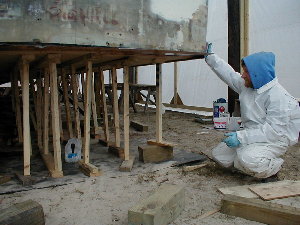
Tom and Jeff, Bottom Planking Scientists
Leonard prepared the marine plywood – one layer of 3/8, one layer of 1/4, and another 3/8 layer to make a full inch of thickness. The three layers of bottom plywood match the existing three layers of mahogany. Three layers of diagonally-planked mahogany is an early Huckins characteristic, before they went to two layers after 1948. Cherokee is one of the last Huckins boats built with the three layer method.
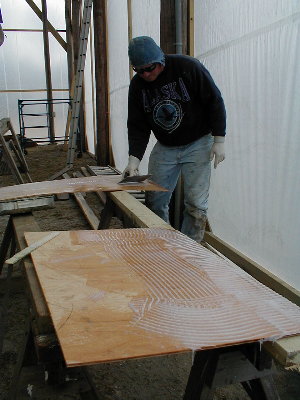
Leonard Applying Epoxy Glue to Bottom Plywood
John has removed the port side deck. He uncovered prior patches (“patches that were poorly done,” he noted) and pockets of rot in the sheer clamp and deck beam. “Next we’re going to cut out the damaged areas and replace them with new lumber,” John explained.
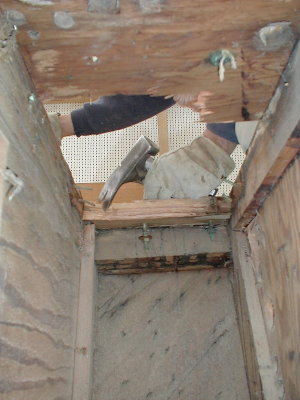
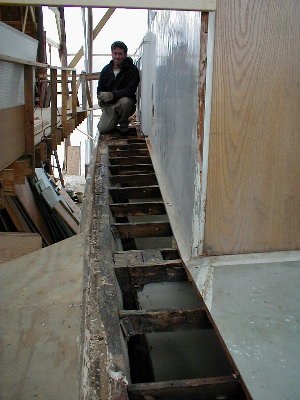
Below Deck View of Rot Removal, John Surveying the Port Side Site
The crew removed all the forward interior mock-up walls so Robbin and Jeanette can get to the hull more easily. They will epoxy-coat the interior as soon as the temperature rises a few degrees, allowing the glue to soak in and penetrate the surface.
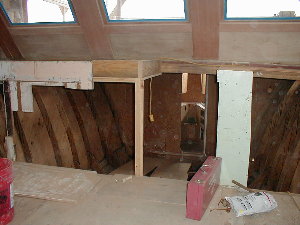
A View from the Salon Clear to the Rope Locker
A patch of white lead-painted deck canvas was removed beneath a pilot house cabinet. This is another remnant of the past, as white lead-painted canvas was a precursor to fiberglass.
Weekly dog news includes the amazing story of Cedar, Tom’s dog, who fell off the deck of Cherokee to the sandy ground below (about thirteen feet or ninety one feet in dog length) and walked away fine. Casey entertained everyone by finding the largest deer femur known to man, and buried it with his nose in the parking area. Deer carcasses abound this winter hunting season. Duck hunting is going strong as well, although nothing like the days of market hunting before the Migratory Bird Act of 1918 was passed. A century ago, along Maryland, Virginia, and North Carolina, hunters in small skiffs used an artillery of battery guns (made from steam pipes) or cannon-sized punt guns (some 12 feet long, 100 – 200 lbs) to kill dozens of birds in one shot. The fowl were shipped to Baltimore and other big cities to satisfy restaurant demand. Early mass-production hunters – whether law abiding or outlaws – acted out of dead winter “cold, hunger, and want,” according to writer Harry Walsh. If only they knew that just one of their old decoys fetches more money today than a lifelong haul of waterfowl ever did! Signing off for now, Barbara “Fish Doctor” Blake







